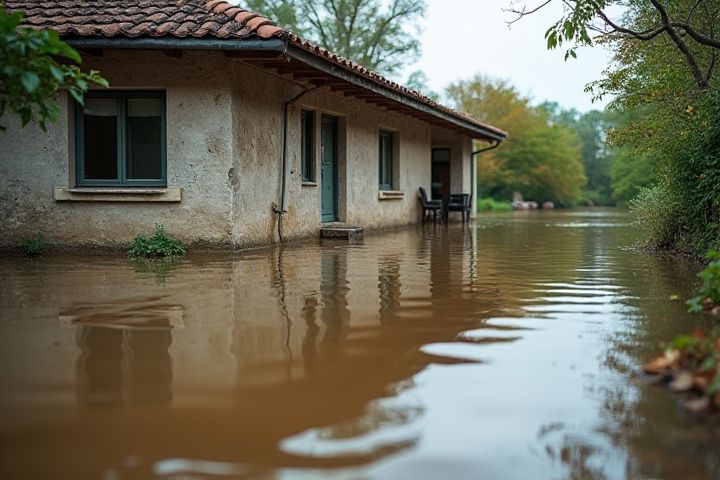
To effectively protect your home from floods, start by elevating critical utilities and appliances above potential flood levels. Incorporate flood barriers or sandbags around your property to divert water away from your foundation. Invest in waterproofing measures such as sealants for walls and floors, which can prevent water intrusion during heavy rainfall. Consider installing a sump pump in your basement to remove accumulated water, providing an additional layer of protection. Regularly inspect and maintain your drainage systems to ensure they are free from debris, allowing for proper water flow during storm events.
How To Protect A House From Floods
Install flood barriers
Installing flood barriers is essential for safeguarding your home against potential flood damage. These robust structures can be made from various materials, including aluminum, steel, or heavy-duty plastic, tailored to fit doorways, windows, and other vulnerable entry points. You should ensure that the barriers are easy to deploy, preferably lightweight yet durable, allowing for quick installation before a flood event. Regular maintenance and inspections of these systems are crucial to guarantee their effectiveness when needed most.
Elevate electrical systems
Elevating electrical systems is a vital strategy for flood protection in your home. By installing electrical outlets and appliances at least one foot above the anticipated flood level, you reduce the risk of damage from water intrusion. This approach not only safeguards your equipment, but it also minimizes the chances of electrical fires and hazards during flood events. Investing in waterproof enclosures for circuit breakers and junction boxes further enhances safety, ensuring your home remains functional and secure during severe weather conditions.
Seal walls with waterproofing compounds
Sealing walls with waterproofing compounds can significantly reduce the risk of flood damage in your home. Apply a high-quality waterproofing membrane to exterior walls, ensuring it creates a seamless barrier against moisture infiltration. For optimal results, choose products that offer a minimum permeability rating of 10 perms, which effectively resists water penetration. Regular maintenance and periodic inspections of these seals are essential to ensure long-lasting protection against potential flooding.
Install sump pumps
Installing sump pumps is essential for protecting your home from flooding, particularly in areas prone to heavy rainfall or rising groundwater. A sump pump works by collecting excess water in a sump basin and pumping it away from your foundation, significantly reducing the risk of water damage. When selecting a sump pump, consider features such as a battery backup system to ensure operation during power outages, and a high-capacity pump to quickly remove large volumes of water. Regular maintenance and testing of your sump pump before the rainy season will ensure that it operates effectively when you need it most.
Elevate appliances and utilities
Elevating appliances and utilities is crucial to mitigating flood damage in your home. Begin by placing your washer, dryer, and water heater on platforms at least one foot above the anticipated flood level. Consider upgrading your HVAC system to a flood-resistant model and installing backflow prevention devices on sewer lines to prevent sewage backup. This proactive approach not only secures your essential equipment but also enhances the overall safety and resiliency of your property against water intrusion.
Implement proper drainage systems
Implementing proper drainage systems is essential for flood protection in your home. Installing French drains can effectively redirect water away from your foundation, while surface drains help manage excess rainwater. Consider incorporating gutters and downspouts that channel rainfall away from the house, ideally discharging at least six feet from the foundation. Regular maintenance, including cleaning these drainage systems, can significantly enhance their performance and longevity, reducing flood risk by up to 50%.
Use sandbags strategically
Using sandbags strategically is an effective method to protect your house from floods. Position the sandbags in key areas such as doorways, window openings, and low-lying points around your home to create barriers against rising water. Ensure you fill the sandbags properly, stacking them in a staggered manner for maximum stability and water resistance. Regularly check the sandbag placement during a flood watch to reinforce barriers and adapt as needed, keeping your home's interior safe from potential water damage.
Elevate the foundation
Elevating your home's foundation is a critical strategy for flood protection, particularly in flood-prone areas. Raising the foundation can be achieved by using methods like pier and beam construction, where the house is built on elevated piers, or by utilizing a flood-resistant foundation system that lifts the structure above expected flood levels. It's essential to consult local flood zone maps to determine the required elevation, which is often set above the Base Flood Elevation (BFE) to ensure safety. Investing in this proactive measure not only helps guard your property against potential water damage but can also enhance its resale value significantly.
Maintain gutters and downspouts
Maintaining gutters and downspouts is essential for protecting your home from flood damage. Ensure that gutters are cleaned at least twice a year to prevent blockages, which can cause water to overflow and pool around your foundation. Install downspouts that direct water at least six feet away from your home to minimize the risk of flooding in the surrounding area. Regularly inspect these systems for leaks or damage, as prompt repairs can significantly lower the chances of water intrusion during heavy rainfall.
Landscape with native plants and rain gardens
Incorporating native plants into your landscaping can significantly enhance flood protection due to their extensive root systems, which improve soil absorption and reduce erosion. Planting a rain garden, strategically positioned to collect runoff, can capture excess water and allow it to percolate into the ground, mitigating flood risks. For optimal results, select native species adapted to your region's climate and soil type; this not only fosters biodiversity but also requires less maintenance and water. By designing your landscape with these elements, you actively contribute to a natural defense against flooding while promoting a sustainable environment around your home.
